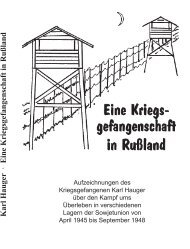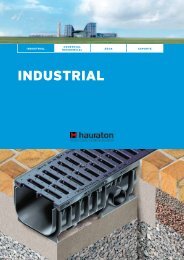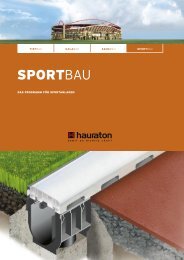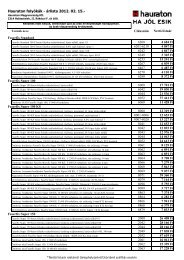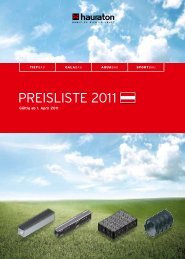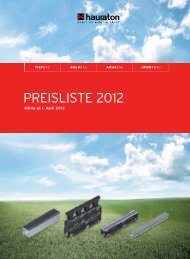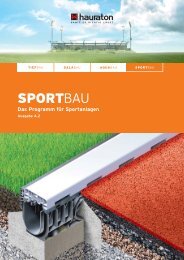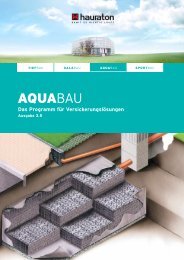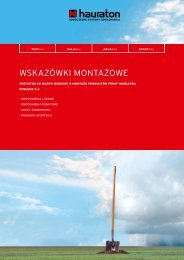tHE rANGE For INFILtrAtIoN SoLutIoN - Hauraton
tHE rANGE For INFILtrAtIoN SoLutIoN - Hauraton
tHE rANGE For INFILtrAtIoN SoLutIoN - Hauraton
Create successful ePaper yourself
Turn your PDF publications into a flip-book with our unique Google optimized e-Paper software.
SOIL PROPERTIES, k f -VALUE<br />
The properties of the soils are of critical importance for<br />
the infiltration characteristics. Sandy soils or those with<br />
a gravel content have a lower infiltration factor kf and<br />
hence allow significantly more infiltration than those<br />
with a high clay content. This k -value is determined by<br />
f<br />
the grain size, composition and volume of the material in<br />
the soil and indicates how fast water can infiltrate (soak<br />
away). Soils with good infiltration characteristics have<br />
k -values between 1O f -3 m/s and 10-6 m/s and range from<br />
sandy gravel to sandy silt.<br />
small grain size –<br />
low permeability<br />
big grain size –<br />
high permeability<br />
RAIN YIELD AND OCCURRENCE<br />
IN ACC. W. DWA-M 153 AND DWA-A 138<br />
We will determine the rain yield for the location of your<br />
infiltration structure on the basis of the kOSTRA data,<br />
a long-term collection of data by the German Weather<br />
Service. These data list the quantity, duration and<br />
intervals of rain for every location in Germany. The<br />
calculation is based on the most unfavourable precipitation<br />
values, thus ensuring an adequate safety factor.<br />
10<br />
20<br />
30<br />
Z = Mai - September<br />
Z = Januar - Dezember<br />
D = 15,0 min<br />
T = 5,0 a<br />
10 10<br />
20<br />
30<br />
Depending on where it comes from, water can have more<br />
or less dirt particles and may carry fine dirt particles.<br />
Engineers can evaluate the properties of the precipitation<br />
water in accordance with worksheet DWA-M 153 and<br />
use these data for the calculations. Depending on the<br />
content of pollutants, worksheet DWA-A 138 distin guishes<br />
between harmless, tolerable and not tolerable water<br />
qualities. All these factors have to be taken into account<br />
when selecting and designing an infiltration system.<br />
GROUNDWATER<br />
40<br />
20 20<br />
30 30<br />
40 40<br />
50 50<br />
60 60<br />
70 70<br />
80 80<br />
90 90<br />
100 100<br />
10<br />
weniger als 12 mm<br />
12 bis 13 mm<br />
13 bis 14 mm<br />
14 bis 16 mm<br />
16 bis 18 mm<br />
18 bis 20 mm<br />
40<br />
One of the most important ecological reasons for the<br />
installation of infiltration systems is the protection of<br />
groundwater. With the help of these systems, precipitation<br />
water is returned to the natural cycle. An adequate<br />
distance (at least 1 m) has to be guaranteed permanently<br />
between the floor of the infiltration structure and the<br />
highest expected groundwater level. In addition, there<br />
must be no polluted layers of soil in the catchment area<br />
of the system. Otherwise, pollutants dissolved in water<br />
may get into the groundwater.<br />
50<br />
50<br />
20 bis 22 mm<br />
22 bis 24 mm<br />
mehr als 24 mm<br />
Map of Germany showing precipitation quantities<br />
(in litres per second and hectare)<br />
60<br />
60<br />
70<br />
70<br />
9



